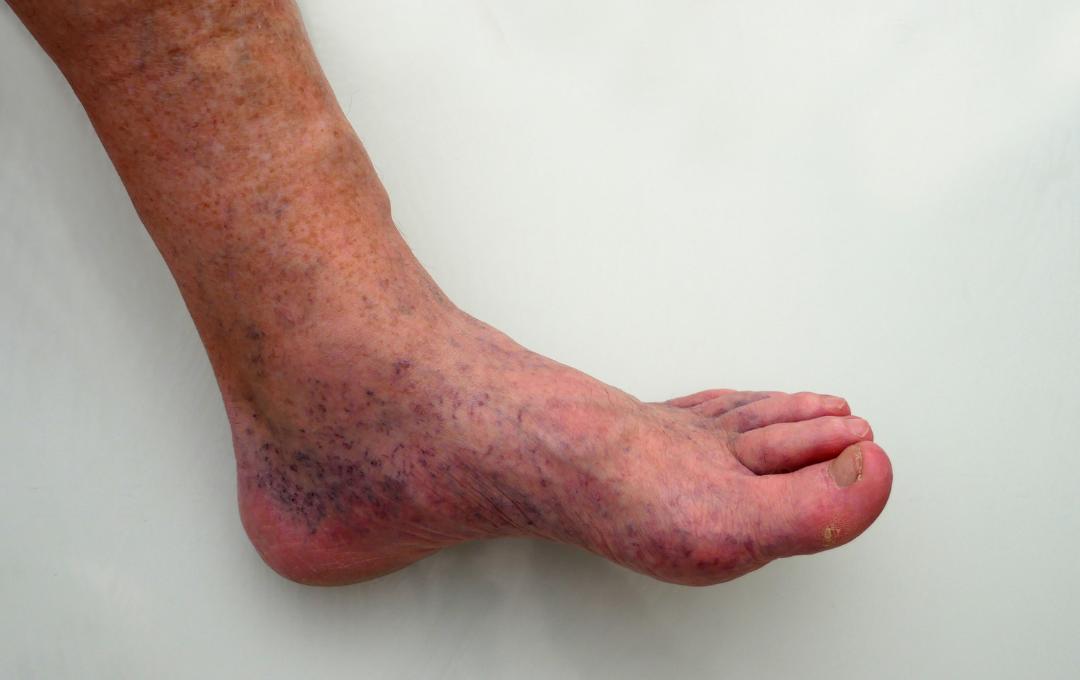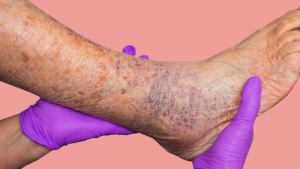
Skin discoloration on the legs can be concerning and may stem from an underlying health condition. Several conditions can cause leg skin discoloration, such as vein disease. This condition occurs when your leg veins struggle to return blood to your heart, causing blood to pool and leak into surrounding tissues. As a result, you may notice discoloration, along with varicose or spider veins. Vein disease can cause painful symptoms and lead to more serious health complications if left untreated.
At USA Vein Clinics, we specialize in minimally invasive vein treatments designed to alleviate discomfort, improve circulation, and restore confidence by addressing vein disease at its source. Don’t wait to find relief—schedule an appointment with one of our vein specialists today and take the first step toward healthier legs.
What Does Skin Discoloration on the Legs Look Like?

Skin discoloration on the legs can appear as a patch of skin that is a darker color than the surrounding tissue. It can look like bruising, being blue or purplish in color. It also may be a brown or rust-like color. With time, the discoloration can become darker and look nearly black.
The technical term for this is hemosiderin staining, a condition that is caused by a problem with the blood vessels in your legs called chronic venous insufficiency.
Since the discoloration is a symptom of vein disease, you will need to address that issue to make sure that the skin discoloration and related symptoms don’t worsen.
Common Causes of Leg Skin Discoloration
Multiple underlying conditions or factors can cause leg skin discoloration. Some common causes of leg skin discoloration include:
- Venous insufficiency: This condition causes poor circulation, which causes blood to pool in the legs and skin discoloration.
- Hyperpigmentation: Hyperpigmentation happens when an affected area is darker than your skin tone This can be caused by an overproduction of melanin, the pigment that gives your skin color.
- Sun exposure: Sun exposure is also a common cause of skin dislocation. Sunburns from prolonged sun exposure can cause other changes in the skin depending on the severity of the burn.
- Trauma and injury: Leg injuries can cause damage to the skin, including discoloration on the legs. Vein disease patients may have long-term damage to their leg skin due to venous ulcers—wounds that never heal.
- Tattoos: Tattoos overlying areas of varicose veins can cause inflammation, potentially leading to skin discoloration on the legs.
Other Health Conditions That Cause Leg Skin Discoloration
Multiple chronic health conditions can lead to leg skin discoloration. This can include:
- Liver conditions: Conditions that affect the liver’s health can affect skin pigment. The skin might darken or have a yellow tint. Some people with liver health conditions might also develop multiple spider veins and changes to skin texture.
- Diabetes: Diabetes can affect circulation. It can lead to brown patches on the skin, often on the legs.
- Eczema and other skin conditions: Skin health conditions, such as eczema, can cause skin changes. This can include irritation, redness, and discoloration on the legs.
A vein specialist at USA Vein Clinics can diagnose the cause of skin discoloration on the legs. Schedule your consultation today by calling 888.768.3467 or using our online scheduler, which also provides free insurance verification.
Circulatory Causes of Discolored Skin on Legs
Poor circulation can result from damaged veins or arteries. Damaged veins can lead to blood pooling in the lower extremities and causing visible skin discoloration. If you are experiencing symptoms of poor circulation, varicose veins, spider veins, and skin discoloration in the legs, consult a vein specialist.
Symptoms of Poor Circulation
Recognizing the symptoms of poor circulation can help you identify early warning signs and seek the necessary treatment. Poor circulation is often associated with damaged veins or arteries, making it difficult for blood to flow properly.
Common symptoms of poor circulation in veins include:
- Swelling in the legs and ankles.
- Numbness or tingling in the lower extremities.
- Cold or pale skin, particularly in the feet.
- Skin discoloration (red, blue, or brown patches).
- Pain or cramping while standing or walking.
Varicose Veins and Spider Veins
Varicose veins and spider veins can be a sign of poor circulation due to vein disease. Varicose and spider veins can cause symptoms such as swelling, pain, and skin changes. This can appear as leg skin discoloration on the lower legs.
Chronic Venous Insufficiency (CVI)
Chronic venous insufficiency (CVI) is a condition that occurs when the veins are damaged. With CVI, blood cannot successfully be returned to the heart and pools in the legs. When blood pools in the legs, it can cause visible changes. This can include discoloration changes that are often most noticeable in the lower legs.
If you are concerned about changes in your veins or skin, schedule a consultation with a specialist at USA Vein Clinics for an accurate diagnosis and personalized treatment plan.
How to Treat Skin Discoloration on Legs
The right treatment for skin discoloration on the legs depends on the condition’s cause. If the cause is vein disease, USA Vein Clinics provides non-invasive treatments that address vein-related causes of skin dislocation on legs, including:
- Radiofrequency Ablation
- Ultrasound-Guided Sclerotherapy (USGS)
- Endovenous Laser Vein Treatment
- ClariVein®
- Varithena
- VenaSeal™
- Sclerotherapy
Lifestyle changes and skin care steps can also help manage skin discoloration due to varicose veins. These methods won’t treat discoloration but can prevent further damage until proper treatment is received.
- Using sun protection to prevent additional discoloration
- Elevating legs when sitting to reduce swelling
- Moisturizing legs to prevent leg dryness and irritation
- Wearing compression stockings to reduce swelling
- Keeping a daily exercise routine to improve circulation
Preventing Future Skin Discoloration on the Legs with USA Vein Clinics
USA Vein Clinics treats various vein disease conditions using minimally invasive, outpatient treatments. These treatments are quicker and less painful than surgery so that patients can return to some activities immediately after the procedure. These FDA-approved treatments effectively reduce symptoms, as verified by the National Institutes of Health.
Regular vein health screenings with USA Vein Clinics can help prevent future skin discoloration on the legs by detecting issues early. Take the first step towards healthier legs by scheduling an appointment with our vein specialists.
FAQs
When should I worry about discolored skin on my legs?
Skin dislocation can sometimes be a sign of a more serious health condition. It’s important to consult a doctor for a proper diagnosis when skin discoloration on the legs is accompanied by:
- Pain in the lower legs
- Swelling in the legs
- Changes to skin texture
- Itchy skin
- Visible veins
- Darkness or redness around the ankles
What causes brown skin discoloration on the lower legs?
Brown skin discoloration on the lower legs can be a result of poor circulation, hyperpigmentation, sun exposure, and injury or trauma.







